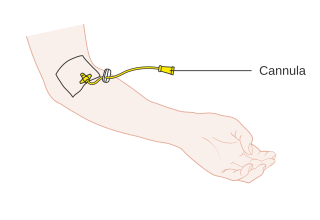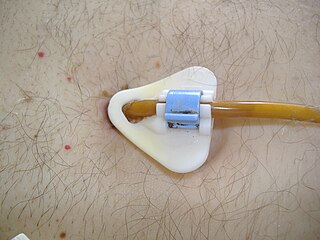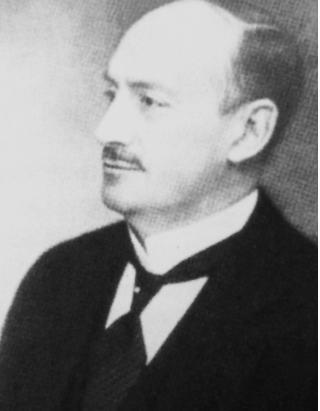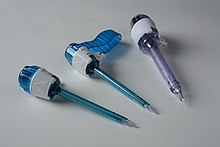Applications
Medical/surgical use
Trocars are used in medicine to access and drain collections of fluid such as in a patient with hydrothorax or ascites.
In modern times, surgical trocars are used to perform laparoscopic surgery. They are deployed as a means of introduction for cameras and laparoscopic hand instruments, such as scissors, graspers, etc., to perform surgery hitherto carried out by making a large abdominal incision, something that has revolutionized patient care. Today, surgical trocars are most commonly a single patient use instrument and have graduated from the "three-point" design that gave them their name to either a flat bladed "dilating-tip" product or something that is entirely blade free. This latter design offers greater patient safety due to the technique used to insert them.
Trocar insertion can lead to a perforating puncture wound of an underlying organ resulting in a medical complication. Thus, for instance, a laparoscopic intra-abdominal trocar insertion can lead to bowel injury leading to peritonitis or injury to large blood vessels with hemorrhage. [9]
Embalming
Trocars are also used near the end of the embalming process to provide drainage of bodily fluids and organs after the vascular replacement of blood with embalming chemicals. Rather than a round tube being inserted, the three-sided knife of the classic trocar would split the outer skin into three "wings" which was then easily sutured closed. In a less obtrusive way, a trocar button can be used in place of a suture. It is attached to a suction hose, usually attached to a water aspirator, but an electric aspirator can also be used. The process of removing gas, fluids, and semi-solids from the body cavities and hollow organs using the trocar is known as aspiration. The instrument is inserted into the body two inches to the (anatomical) left and two inches up from the navel. After the thoracic, abdominal, and pelvic cavities have been aspirated, the embalmer injects cavity fluid into the thoracic, abdominal and pelvic cavities, usually using a smaller trocar attached via a hose connected to a bottle of high-index cavity fluid. The bottle is held upside down in the air so as to let gravity take the cavity fluid through the trocar and into the cavities. There is a small thumb hole attached to the fluid injector to control the flow of liquid. The embalmer moves the trocar in the same manner used when aspirating the cavities. In order to fully and evenly distribute the chemical, it is recommended to use 1 bottle of cavity fluid for the thoracic cavity and 1 for the abdominal cavity.
After cavity embalming has been finished, the puncture is commonly sealed using a small plastic object resembling a screw, called a trocar button.
Veterinary use
Trocars are widely used by veterinarians not only for draining hydrothorax, ascites, or for introducing instruments in laparoscopic surgery, but for acute animal-specific conditions as well. In cases of ruminal tympany in cattle, a wide-bore trocar may be passed through the skin into the rumen to release trapped gas. [10] In dogs, a similar procedure is often performed for patients presenting with gastric dilatation volvulus in which a wide-bore trocar is passed through the skin into the stomach to immediately decompress the stomach. Depending on the severity of clinical signs on presentation, this is often performed after pain management has been administered but prior to general anaesthesia. Definitive surgical treatment involves anatomical repositioning of the stomach and spleen followed by a right-sided gastropexy. [11] Depending on the severity, partial gastrectomy and/or splenectomy may be indicated if the relevant tissues have necrosed due to ischemia caused by torsion/avulsion of the supplying vasculature.
The term abdominal surgery broadly covers surgical procedures that involve opening the abdomen (laparotomy). Surgery of each abdominal organ is dealt with separately in connection with the description of that organ Diseases affecting the abdominal cavity are dealt with generally under their own names.

General surgery is a surgical specialty that focuses on alimentary canal and abdominal contents including the esophagus, stomach, small intestine, large intestine, liver, pancreas, gallbladder, appendix and bile ducts, and often the thyroid gland. General surgeons also deal with diseases involving the skin, breast, soft tissue, trauma, peripheral artery disease and hernias and perform endoscopic as such as gastroscopy, colonoscopy and laparoscopic procedures.

The abdominal cavity is a large body cavity in humans and many other animals that contain organs. It is a part of the abdominopelvic cavity. It is located below the thoracic cavity, and above the pelvic cavity. Its dome-shaped roof is the thoracic diaphragm, a thin sheet of muscle under the lungs, and its floor is the pelvic inlet, opening into the pelvis.

Laparoscopy is an operation performed in the abdomen or pelvis using small incisions with the aid of a camera. The laparoscope aids diagnosis or therapeutic interventions with a few small cuts in the abdomen.

Peritonitis is inflammation of the localized or generalized peritoneum, the lining of the inner wall of the abdomen and cover of the abdominal organs. Symptoms may include severe pain, swelling of the abdomen, fever, or weight loss. One part or the entire abdomen may be tender. Complications may include shock and acute respiratory distress syndrome.

An appendectomy or appendicectomy is a surgical operation in which the vermiform appendix is removed. Appendectomy is normally performed as an urgent or emergency procedure to treat complicated acute appendicitis.

A cannula is a tube that can be inserted into the body, often for the delivery or removal of fluid or for the gathering of samples. In simple terms, a cannula can surround the inner or outer surfaces of a trocar needle thus extending the effective needle length by at least half the length of the original needle. Its size mainly ranges from 14 to 26 gauge. Different-sized cannula have different colours as coded.

Gastric dilatation volvulus (GDV), also known as gastric dilation, twisted stomach, or gastric torsion, is a medical condition that affects dogs in which the stomach becomes overstretched and rotated by excessive gas content. The word bloat is often used as a general term to mean gas distension without stomach torsion, or to refer to GDV.

Percutaneous endoscopic gastrostomy (PEG) is an endoscopic medical procedure in which a tube is passed into a patient's stomach through the abdominal wall, most commonly to provide a means of feeding when oral intake is not adequate. This provides enteral nutrition despite bypassing the mouth; enteral nutrition is generally preferable to parenteral nutrition. The PEG procedure is an alternative to open surgical gastrostomy insertion, and does not require a general anesthetic; mild sedation is typically used. PEG tubes may also be extended into the small intestine by passing a jejunal extension tube through the PEG tube and into the jejunum via the pylorus.
Colic in horses is defined as abdominal pain, but it is a clinical symptom rather than a diagnosis. The term colic can encompass all forms of gastrointestinal conditions which cause pain as well as other causes of abdominal pain not involving the gastrointestinal tract. What makes it tricky is that different causes can manifest with similar signs of distress in the animal. Recognizing and understanding these signs is pivotal, as timely action can spell the difference between a brief moment of discomfort and a life-threatening situation. The most common forms of colic are gastrointestinal in nature and are most often related to colonic disturbance. There are a variety of different causes of colic, some of which can prove fatal without surgical intervention. Colic surgery is usually an expensive procedure as it is major abdominal surgery, often with intensive aftercare. Among domesticated horses, colic is the leading cause of premature death. The incidence of colic in the general horse population has been estimated between 4 and 10 percent over the course of the average lifespan. Clinical signs of colic generally require treatment by a veterinarian. The conditions that cause colic can become life-threatening in a short period of time.
Intestinal malrotation is a congenital anomaly of rotation of the midgut. It occurs during the first trimester as the fetal gut undergoes a complex series of growth and development. Malrotation can lead to a dangerous complication called volvulus, in which cases emergency surgery is indicated. Malrotation can refer to a spectrum of abnormal intestinal positioning, often including:
Abdominal bloating is a short-term disease that affects the gastrointestinal tract. Bloating is generally characterized by an excess buildup of gas, air or fluids in the stomach. A person may have feelings of tightness, pressure or fullness in the stomach; it may or may not be accompanied by a visibly distended abdomen. Bloating can affect anyone of any age range and is usually self-diagnosed, in most cases does not require serious medical attention or treatment. Although this term is usually used interchangeably with abdominal distension, these symptoms probably have different pathophysiological processes, which are not fully understood.

Veterinary surgery is surgery performed on non-human animals by veterinarians, whereby the procedures fall into three broad categories: orthopaedics, soft tissue surgery, and neurosurgery. Advanced surgical procedures such as joint replacement, fracture repair, stabilization of cranial cruciate ligament deficiency, oncologic (cancer) surgery, herniated disc treatment, complicated gastrointestinal or urogenital procedures, kidney transplant, skin grafts, complicated wound management, and minimally invasive procedures are performed by veterinary surgeons. Most general practice veterinarians perform routine surgeries such as neuters and minor mass excisions; some also perform additional procedures.

Hans Christian Jacobaeus was a Swedish internist born in Skarhult.
Pyloromyotomy is a surgical procedure in which a portion of the muscle fibers of the pyloric muscle are cut. This is typically done in cases where the contents from the stomach are inappropriately stopped by the pyloric muscle, causing the stomach contents to build up in the stomach and unable to be appropriately digested. The procedure is typically performed in cases of "hypertrophic pyloric stenosis" in young children. In most cases, the procedure can be performed with either an open approach or a laparoscopic approach and the patients typically have good outcomes with minimal complications.
Canine gastropexy is a surgical procedure performed most commonly in large breed dogs to prevent gastric dilatation volvulus (GDV), commonly known as bloat. GDV is a life-threatening condition in which the stomach flips over and expands, trapping air and gases in the stomach. Circulation to the stomach and spleen is subsequently interrupted, resulting in shock which can be fatal.
Cholecystostomy or (cholecystotomy) is a medical procedure used to drain the gallbladder through either a percutaneous or endoscopic approach. The procedure involves creating a stoma in the gallbladder, which can facilitate placement of a tube or stent for drainage, first performed by American surgeon, Dr. John Stough Bobbs, in 1867. It is sometimes used in cases of cholecystitis or other gallbladder disease where the person is ill, and there is a need to delay or defer cholecystectomy. The first endoscopic cholecystostomy was performed by Drs. Todd Baron and Mark Topazian in 2007 using ultrasound guidance to puncture the stomach wall and place a plastic biliary catheter for gallbladder drainage.
A Veress needle or Veres needle is a spring-loaded needle used to create pneumoperitoneum for laparoscopic surgery. Of the three general approaches to laparoscopic access, the Veress needle technique is the oldest and most traditional.
Ruminal tympany, also known as ruminal bloat, is a disease of ruminant animals, characterized by an excessive volume of gas in the rumen. Ruminal tympany may be primary, known as frothy bloat, or secondary, known as free-gas bloat.











